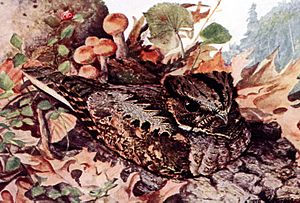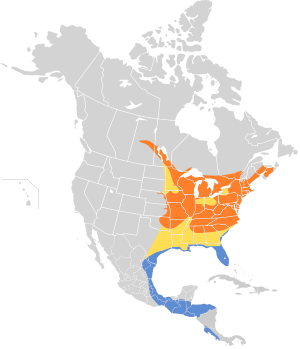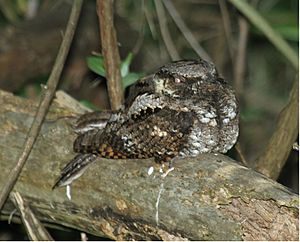Eastern whip-poor-will facts for kids
Quick facts for kids Eastern whip-poor-will |
|
|---|---|
 |
|
| Adult male | |
| Conservation status | |
| Scientific classification | |
| Genus: |
Antrostomus
|
| Species: |
vociferus
|
 |
|
| Synonyms | |
|
Caprimulgus vociferus Wilson, 1812 |
|
The eastern whip-poor-will (Antrostomus vociferus) is a cool bird from North America. It's a medium-sized nightjar, usually about 22 to 27 centimeters long. You might hear its unique song, which sounds like "whip-poor-will," but it's very hard to see. This is because its feathers help it blend in perfectly with its surroundings, like a master of camouflage.
Contents
What Does It Look Like?
This bird is about 22 to 27 centimeters (9 to 11 inches) long. Its wings can spread out to about 45 to 50 centimeters (18 to 20 inches). It weighs around 42 to 69 grams (1.5 to 2.4 ounces).
Adult whip-poor-wills have feathers that are a mix of grey, black, and brown. This mottled pattern helps them hide. They have a very short beak and a black throat. Male birds have a white patch below their throat. They also have white tips on their outer tail feathers. Females have light brown patches in these same areas.
Sometimes, people confuse this bird with the chuck-will's-widow. That bird has a similar call, but it's slower and lower-pitched.
Where Do They Live and What Do They Do?
Eastern whip-poor-wills live in forests with different kinds of trees. You can find them in central and southeastern Canada and the eastern United States. When winter comes, they migrate south. They fly to the southeastern United States, eastern Mexico, and Central America.
These birds are active at night. They catch insects while flying, like a skilled hunter. During the day, they usually sleep, hidden among the leaves. Eastern whip-poor-wills build their nests on the ground. They choose shady spots among dead leaves. Usually, they lay two eggs at a time. The mother bird will often stay on her nest, even if you get very close.
Scientists have actually split the whip-poor-will into two different species. The birds in the eastern parts are now called the eastern whip-poor-will. The birds living in the southwestern United States and Mexico are called the Mexican whip-poor-will. They were separated because they live in different places, sing different songs, lay different colored eggs, and their DNA is different.
Why Are They Important to Protect?
The eastern whip-poor-will is becoming rare in some places. In 2017, its conservation status changed. It went from "least concern" to "near threatened" on the IUCN Red List. This means they are getting closer to being endangered.
Studies show that the number of eastern whip-poor-wills dropped by over 60% between 1970 and 2014. This decline is likely due to a few things. One big reason is the loss of their forest homes. Also, there are fewer flying insects for them to eat. This is because of pesticides and changes in farming. These things hurt the insect populations that whip-poor-wills rely on for food.
Groups like BirdLife International say that special programs are very important. These programs help protect the species and try to reverse its decline.
Images for kids
-
A rarely-seen Eastern Whip-poor-will by day in Philadelphia, Pennsylvania.
See also
 In Spanish: Chotacabras cuerporruín para niños
In Spanish: Chotacabras cuerporruín para niños




